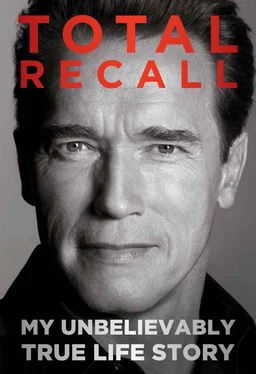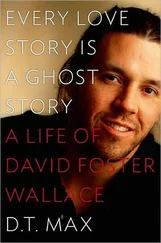The workdays often ran to sixteen hours, and most nights I simply stayed in Sacramento. I liked the weight and the complexity of the challenges and being constantly on the move. But I missed Maria and the kids, and I still made sure to try to spend Friday plus every weekend in LA.
This schedule had worked in my first term, mainly, I thought, because of Maria’s skill as a mom. But one evening in spring when I came back from Sacramento, and we were all sitting around the kitchen table, Christina started to cry. “Daddy, you’re never home,” she said. “You’re always in Sacramento. You didn’t show up at school when I had my recital.” Another one said, “You didn’t show up for parents’ day. It was just Mommy there.” The next one started crying and said, “Yeah, me too. You missed my soccer game.” All of a sudden, there was this chain reaction. All of them were crying, and they all had a complaint.
Christina must have seen the shock on my face. I was having such a great time being governor that I’d completely missed what was boiling at home. She said, “Sorry, Daddy, but I had to say it.”
“No, Christina,” said Maria. “That’s okay. I think it’s important that you tell your daddy what you think and what you feel. So just tell him everything.” She was unhappy too that I was away so much, and encouraged them all to speak up.
I can be such a locomotive sometimes. Now I worried about how long they’d felt this way and how long it had taken them to have the courage to say it. I’d always told them that in a family everyone has to make sacrifices. Whenever you have six people together, no one can go off and do everything he or she wants 100 percent of the time. Well, now it was my turn. I promised that from that moment, I would spend only one night a week in Sacramento. “I might have to leave some mornings before you get up, and I might get home just as you’re going to sleep,” I said. “But from now on, I’ll be here.”
They always say that politics erodes marriages. You get so immersed in the job that there are side effects on the people you love. Even if you succeed in partly protecting your wife and kids from the public spotlight, they feel they’re sharing you and losing you. Maria, of course, was strong and had her own career. When she saw that my passion for being governor was causing us to drift apart, she did the best she could do under the circumstances: took great care of the kids, stepped up to the opportunities and responsibilities of being First Lady, was there for me when I needed her. And waited.
_
Just before a press conference the previous spring while we starting the reelection campaign, my top staff had begged me not to take on health care reform. Susan Kennedy and Daniel Zingale brought it up specifically: “Please don’t say you’re going to do it.” Daniel was our health care guru. Before becoming Maria’s chief of staff, he’d founded California’s Department of Managed Health Care for Governor Davis.
But I was feeling my oats, and I went out and told the media, “I’m going to do health care reform in my second term.” Afterward, Susan and Daniel were saying, “Oh, shit, he just grabbed the third rail.” They begged me not to promise we’d have a plan ready in time for the State of the State address; they said it couldn’t be done. So the next time I saw a reporter, I said, “and I will have a plan by the State of the State address.” Susan joked later that she had to hold a paper bag over Daniel’s mouth to stop him hyperventilating when he heard. He couldn’t believe we were going to have to develop a comprehensive health care reform plan in eight months for the state of California; they said it took two years in Massachusetts, a state smaller than Los Angeles County. I had to calm everyone down.
Their fear was easy to understand. Trying to reform health care had almost destroyed Bill Clinton’s presidency. And the same health care demons that confronted America also confronted us as a state: soaring costs, inefficiency, fraud, rising burdens for employers and policyholders, and millions of people uninsured. But I’d always thought it was a disgrace that the greatest country in the world did not provide a health care system for all of its people, as many European countries do. That said, I believe in the private sector and was opposed to any government-run system like single payer. We framed the idea differently than anybody before or since.
I didn’t try to guilt-trip businesses and people who already had health insurance into taking on the huge extra costs of the uninsured and the underinsured. Instead, I argued that they were already paying these bills through a big hidden tax: their own rising health care costs. So by covering the uninsured directly, they would be paying no more than they were now, and health care could be managed more efficiently. I also spotlighted that most Californians without health insurance—three-quarters of them, in fact—had jobs. This was the core of California: young working families who weren’t adequately covered.
Daniel Zingale led a team that did a brilliant job of creating our plan. Universal coverage was going to require sacrifice from all the players—hospitals, insurers, employers, doctors—and he brought them all to the table and got them involved. The plan had three components. Coverage for all. A requirement that every Californian buy insurance. And a requirement that insurers guarantee coverage for everyone, regardless of age and including those with pre-existing conditions. There were also subsidies for people who couldn’t afford insurance on their own, as well as aggressive measures to control costs and to focus on prevention.
So instead of avoiding health care, I made it a top priority in 2007, which I talked up as the year of health care. Public events and private meetings on the issue were on my schedule every day. I traveled the state meeting patients, doctors, nurses, and hospital CEOs. I went to roundtables mostly just to sit and listen. In May I actually got Jay Leno to let me talk about health care finance on The Tonight Show ; Jay gave an example of a relative who had spent three months in a hospital in England and paid only $4,500.
Assembly Speaker Fabian Núñez worked his tail off corralling the big labor unions to support health care reform, while I worked the major business groups. Together we negotiated every major detail with hospitals, doctors’ groups, and patient advocates on a comprehensive plan that would pay for itself, require everyone to have health insurance, and reduce the cost shift to taxpayers. By December, the California Health Care Security and Cost Reduction Act had won the support of the assembly, despite opposition from the nurses’ union and liberal Democrats who were holding out for a government-run single-payer plan to cover everybody.
But in January 2008, after a year of intense work, health care reform wasn’t even taken up for a vote in the state senate. The plan simply died in a senate committee. Word was that the senate leader, Democrat Don Perata, couldn’t stomach that this young upstart Democratic speaker, working with a Republican governor, would deliver two of the biggest reform measures in modern California history: climate change and health care reform. Some Democrats complained openly that it was political malpractice to give a Republican governor such a huge victory on “Democratic” issues. (In the early seventies, Teddy Kennedy followed a similar line in blocking President Nixon’s national health care reform.) I couldn’t believe that a major issue for the people of California could be derailed because of what amounted to a political snit between two Democratic leaders in the legislature.
It was a major defeat. But I don’t regret the effort, because it wasn’t a defeat for the cause of health care. Our legislation was studied closely in Washington and was one of the models for national health care reform in 2010. Our plan addressed some of the perceived weaknesses in Mitt Romney’s pioneering health care reform in Massachusetts by strengthening the individual mandate and focusing on prevention—key cost containment measures. In effect, our health care reform became America’s, and California led the way.
Читать дальше












